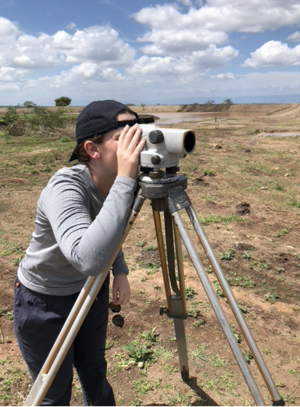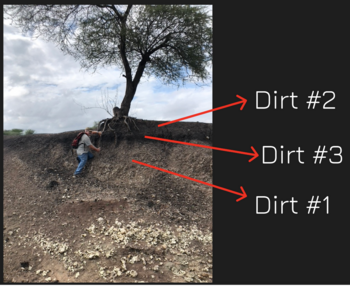½ Meter of Freeboard and Drake
Over winter break, myself, Cosima, Becca, Dave, and Jordan traveled to Naitolia to monitor and evaluate the effectiveness of our pond rehabilitation project in the community. In Cosima’s previous post she talks about how we evaluated the implementation through household surveys, in this post I am going to talk about our surveys of the pond and the surrounding dirt.
On the trip one of the central goals was to determine the stability of the pond embankment. We needed to ensure that the spillway built during an implementation trip was the lowest point around the pond (i.e. that there was at least ½ meter of freeboard around the rest of the embankment. Ensuring that there was a reasonable amount of freeboard was essential to pass over maintenance and construction to the community and their NGO partners. In a region with severe wet and dry conditions, the pond needed leeway to adapt to weather conditions and ensure the community has a water source even through shifting climates.
To conduct the survey we used land surveying equipment that allowed us to measure the elevation of different points around the pond. The tool required the look of a true engineer - a hat on backwards, a slight squat with a notebook and sunglasses in hand, and of course the perfect squint of the eye to make out the color and number on the meter stick on the other side of the pond.

After reading the numbers we compared it all to the height of the spillway (set at 100m) and found that all other survey points resulted in an elevation > 100m. Meaning we had at least ½ meter of freeboard around the entire pond (hooray!!). We were ready to pass over maintenance to the community, there was just one thing left. The famous Dave dirt lesson.
The pond and surrounding area was composed of three main dirts:

1- Dirt #1 (Epic/Amazing/Ethereal Dirt - this stuff was the cream of the crop - best for pond embankment)
2- Dirt #2 (Okay/Average/Normal Dirt - purely acceptable - best for erosion gullies)
3 - Dirt #3 (Run Away/Scary/Crumbly Dirt - run away - get this dirt as far from the pond as possible)

Dave’s lesson included descriptions of the three dirt types as well as demonstrations of their various clay content. After our lesson, we met with the water committee to share our findings on the pond and the dirt around it. The primary goal was to say that the pond was stable and that future repairs should be done using Dirt #1 in the embankment.
What I thought would be a trip filled with petri dishes, water samples, and dirt ended up also being a trip about the interaction of nature and a community. Delivering water to nearly 1800 people across kilometers and kilometers of space created a complex water issue. However, the added complexity from elephants destroying distribution points, hyenas coming in at night to steal a goat, and drought significantly weakening the cattle made the situation in Naitolia truly unique. The often tumultuous relationship between the Maasai in Naitolia and the natural world that they rely upon created a water problem deeply intertwined with the society and standards of the community.